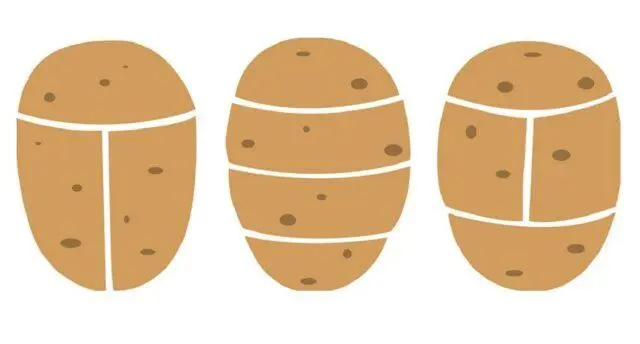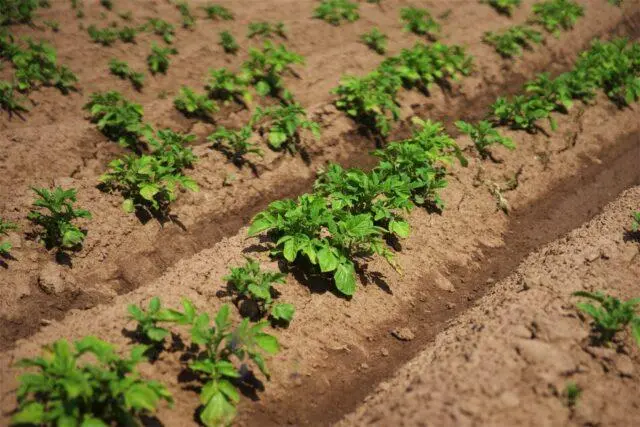Contents
Potatoes are one of the most popular garden crops that summer residents prefer to plant. But in order for the harvest to be good, the plant needs to allocate a lot of territory for planting. Fortunately, in a small area, you can also achieve good results if you resort to tricks. For example, planting potatoes with eyes is one of such tricks of summer residents, which allows you to save planting material and at the same time increase productivity.

Planting potatoes with eyes is an economical method that has proven to be highly effective.
Features of planting potatoes with eyes
The technology of planting potatoes with eyes is considered a highly productive method, due to which not only the quantity of the crop increases, but also its quality. The reason for this is that each shoot (eye) is a separate plant, which, as it grows, forms its own root system. There can be many such shoots on the mother tuber, and when they get into favorable conditions, they begin to germinate, and then compete with each other for living space, nutrients and moisture.
In the process of struggle, shoots spend a lot of energy, as a result, the root system of a strong plant begins to suppress the rest. On its stolons, of course, large root crops are formed, but their number is limited, since the plant gets only half of the seat. Other shoots located in the remaining area also form root crops, but they are much smaller in size.
If you plant the eyes of a potato divided into parts, then in the future the plants will not have to compete with a large number of shoots. Their forces will be spent just on the formation of root crops, which means that the number of tubers will increase as well as the quality.
Pros and cons of the method
In addition to a high yield, potato propagation with eyes has a number of other advantages:
- saving planting material, since 2-3 parts with eyes (viable shoots) can be obtained from one mother tuber;
- the germination of potatoes was noted to be simultaneous and faster, since the shoots do not waste energy on competition and receive more nutrients from the soil;
- the crop is better due to the greater intake of nutrients by just one bush that forms tubers;
- This method can propagate any variety of potatoes.
Among the minuses it is worth noting:
- for planting with eyes, it is necessary to choose high-quality large maternal tubers;
- it takes more time to prepare planting material;
- after planting, plants need good care for germination.
But even despite the shortcomings of the method, the end result in the form of healthy and large tubers will be an excellent reward for the effort and work expended.
Preparation of planting material
Like planting any plant, growing potatoes with eyes is based on the proper preparation of planting material. Only healthy medium or large root crops should be chosen as the mother tuber.
There are several options for partitioning:
- first, the upper part of the tuber is cut off (opposite to the place where it was previously attached to the stolon), the remaining half is cut lengthwise;
- the tuber is cut into three parts across;
- root crops are divided into three parts across, then the middle part is cut in half lengthwise.

The main options for dividing the tuber into parts with eyes
After dividing the tubers into parts, they should be stored until planting. To do this, they are laid out in one layer on a covered floor in a room at room temperature. Leave it like this for 3-7 days until the places of cuts become rough (corky). It is important to monitor the parts, rotten and damaged must be removed immediately.
After the sections have dried, you can transfer the planting material to the basement if it is harvested in the fall, or the next step is immediately carried out – vernalization. The essence of the procedure is to let the eyes germinate at room temperature in diffused light. Thanks to vernalization, the germination time of potatoes is reduced.
If the planting material is harvested from autumn, then in a month it is taken out of the storage place for warming up in a room with a temperature of + 18- + 20 ºC for 4-6 days. When the first eyes appear, the seed tubers are then laid out in boxes in 1-2 layers and transferred to the light, while the temperature should be up to +10 ºC. Under these conditions, the shoots continue to grow, and until the time comes to plant potatoes with eyes, the shoots will already be about 2 cm.
How to plant potatoes with eyes
The scheme for planting potatoes with eyes is slightly different from planting with whole tubers. The distance in the row between the holes should be less. For small parts, planting at a distance of 10-15 cm is allowed, for larger shares – 20 cm. The aisle is also maintained at 40-60 cm to simplify subsequent care. When planning to plant potatoes with eyes in a checkerboard pattern, the distance between rows can be 20-25 cm. Parts with eyes should be buried no more than 7 cm.
It is important to properly fertilize the soil, because the parts with eyes will not have the same supply of nutrients that whole tubers have. Therefore, when digging holes, they first lay compost, onion peel and egg shells, as well as ash. After that, parts of the tubers are already laid so that the sprouts are directed upwards, and covered with soil no more than 10 cm.
Care after landing
After planting potatoes with eyes, after 2-2,5 weeks, when the first shoots only begin to “peck”, hilling is carried out (earthen ridges are formed in each row about 25 cm high). This is necessary so that future tubers have enough space and sunlight does not seep through.
After 5-7 days after the first hilling, shoots should appear. They, as a rule, begin to grow intensively, and so that weeds do not drown them out, it is necessary to remove them in a timely manner.
Potatoes usually do not need watering, but in very dry weather during the period of active growth, soil irrigation can be done. It is enough to use water at the rate of 15 liters per 1 sq. m.
The second time hilling is carried out when the tops reach 15 cm. It is best done after rain or after watering.

Top dressing and prevention of the appearance of diseases and pests are carried out identically to those with the classical planting method.
Conclusion
Planting potatoes with eyes is a great method for getting a good harvest. This method has many advantages, including saving seed material and improving the quality of grown tubers.









